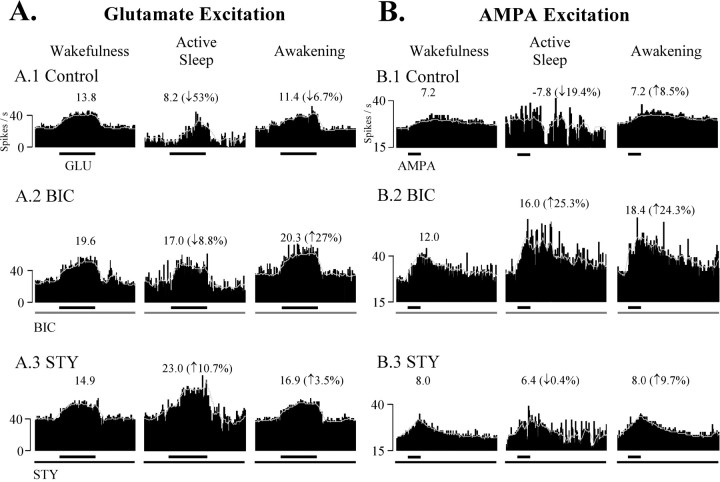Fig. 6.
BIC and STY effects on AS-specific suppression of EAA-induced excitations of DSCT neurons. Each trace is a computer-averaged perievent histogram (with sliding average) of a DSCT neuron to consecutive GLU (A, −86 nA, 10 sec, 20 sec intervals, 5 trials) or AMPA (B, −60 nA, 6 sec, 60 sec intervals, 4 trials) pulses applied during wakefulness, AS, and reawakening. Numbers over each perievent histogram represent the EAA-evoked response magnitude corrected for spontaneous spike activity (see Materials and Methods). Neurons were tested with BIC and STY in separate SCs. The control GLU response was suppressed by 53.0% during AS (A1, Control). During the sustained release of BIC (40 nA, 17 min; A2, BIC), AS-specific suppression measured only 8.8% (A2, BIC) and was abolished after STY administration (30 nA, 21 min; A3, STY). In another DSCT neuron, the control AMPA-evoked response during wakefulness was reduced by ∼19% during AS (B1, Control). In contrast, in the presence of BIC, the AMPA-evoked response was facilitated by ∼25% during AS (25 nA, 15.4 min; B2, BIC). In the presence of STY (50 nA, 19 min; B3, STY), AS-specific suppression was also abolished. Effects similar to A andB were obtained for five other DSCT neurons (GLU,n = 3; AMPA, n = 2). Spontaneous and EAA-evoked data from these seven DSCT neurons were combined and tabulated in Table 3.

